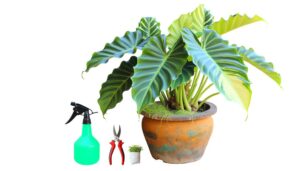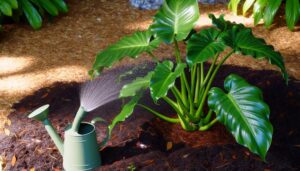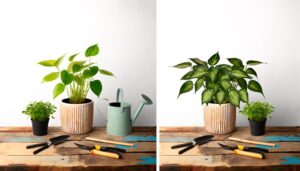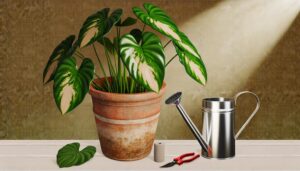Split Leaf Philodendron Care Outside
Split Leaf Philodendron (Monstera deliciosa) is an evergreen, tropical vine originating from Central American rainforests. Best conditions for outdoor growth include temperatures of 60-75°F, humidity above 60%, and protection from strong winds.
The plant thrives in well-drained, peat-based soil and bright, indirect light. Carefully choose the location, ensuring high humidity, wind protection, and access to water.
Proper watering, disease monitoring, and winterization are critical for plant health. Learn to recognize common problems like leaf yellowing and pests for effective management.
Dive further for insights on propagating your Philodendron outdoors.
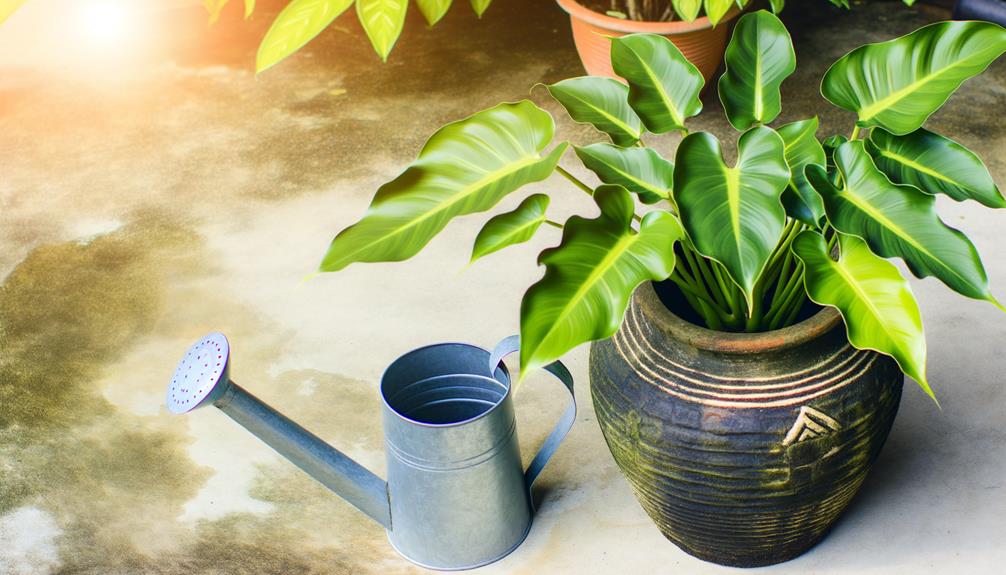
Key Takeaways
- Choose a location with bright, indirect light, temperature 65-85°F, and high humidity.
- Plant in a hole twice the root ball's size, enriched with organic matter.
- Water based on climate, season, and soil type to prevent overwatering.
- Monitor for pests like aphids, mealybugs, spider mites, and implement natural control methods.
- In winter, reduce watering, apply mulch, and protect potted plants from freezing temperatures.
Understanding Split Leaf Philodendron
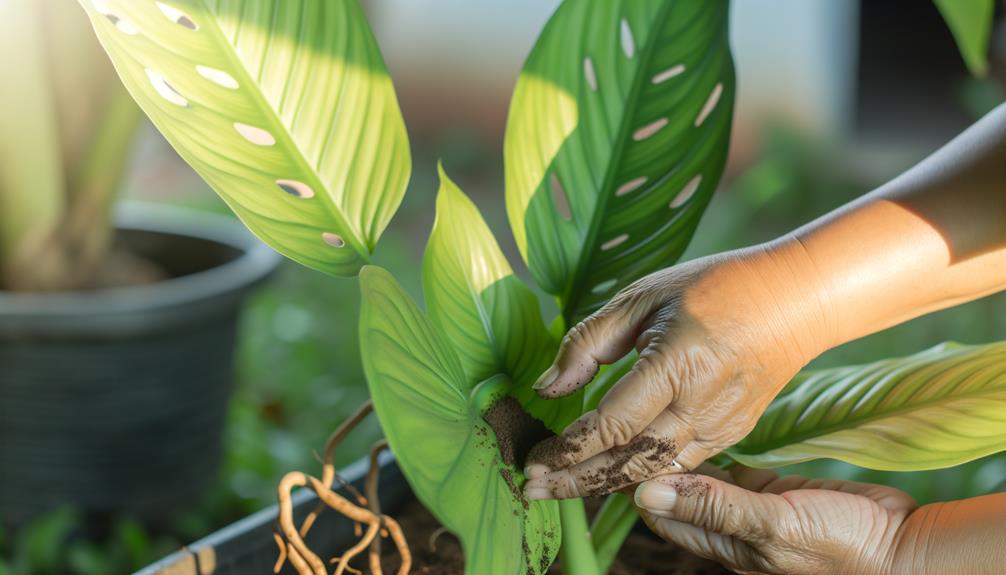
The Split Leaf Philodendron, scientifically recognized as Monstera deliciosa, is a type of evergreen tropical vine that is a part of the Araceae family, renowned for its distinctive fenestrated leaves.
Originating from the rainforests of Central America, this plant has adapted to life under the forest canopy with its unique leaf structure allowing sunlight to filter through to the lower leaves. The large, glossy leaves can make a dramatic statement in landscaping and outdoor garden designs.
Additionally, Monstera deliciosa is a robust plant, demonstrating resilience in a variety of soil conditions. However, its preference leans towards well-drained, peat-based soil. For best growth, it requires indirect light, high humidity, and a steady temperature above 50°F.
Understanding these fundamentals can assist others in providing the top care for this magnificent plant.
Optimal Outdoor Conditions
Drawing from the fundamental understanding of the Split Leaf Philodendron's native environment, creating ideal outdoor conditions for this plant involves replicating aspects of the Central American rainforest where it naturally thrives. This entails establishing a warm, humid environment with minimal temperature fluctuations.
Split Leaf Philodendrons prefer temperatures between 60 – 75 degrees Fahrenheit and thrive in humidity levels above 60%. They require rich, well-draining soil that mimics the nutrient-rich forest floor. These plants also need protection from strong winds which can damage their large, delicate leaves.
Lastly, make sure that the plant gets bright, indirect light, as direct sunlight can cause leaf burn. By mindfully creating these conditions, you provide a nurturing environment that allows the Split Leaf Philodendron to flourish.
Choosing the Perfect Location
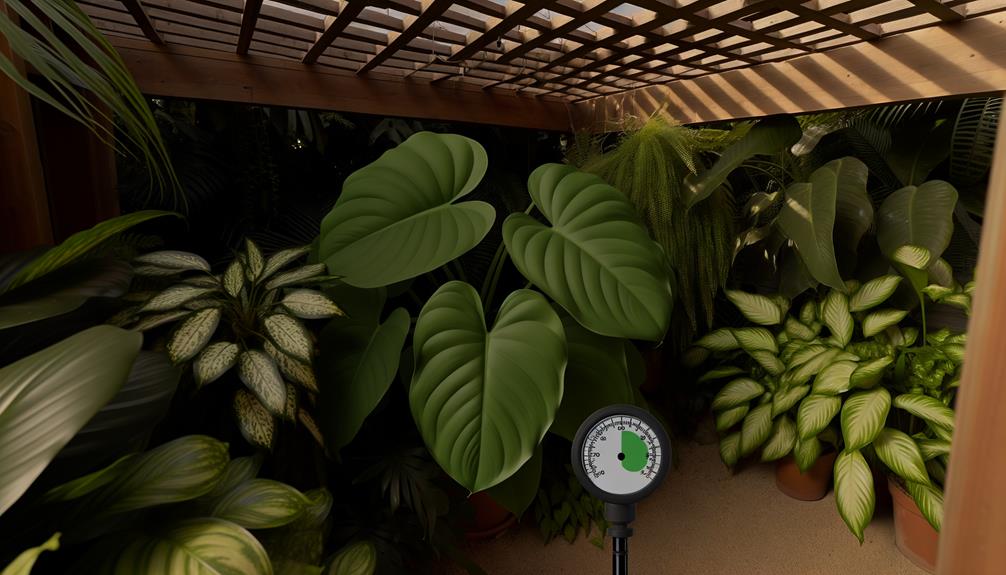
Selecting an ideal location for your Split Leaf Philodendron outdoors necessitates careful consideration of various environmental factors to closely emulate its natural habitat. It's essential to align the requirements of this tropical plant with the microclimate of your garden.
To help you choose the perfect location, consider the following criteria:
- *Light conditions:* Philodendrons thrive in bright, indirect light. Avoid direct sunlight as it can scorch the leaves.
- *Temperature:* Choose a spot where the temperature consistently stays between 65-85°F.
- *Humidity:* As tropical plants, they prefer a high humidity environment. Proximity to a water feature can be beneficial.
- *Wind protection:* Exposed locations can cause leaf damage. Opt for a sheltered spot.
Planting Your Philodendron Outdoors
Upon securing a perfect spot, the next step in nurturing your Split Leaf Philodendron involves the careful execution of its planting process, making sure that all conditions are conducive for its vigorous growth.
Dig a hole twice the width of the root ball and just as deep. This allows for proper root spread and establishment. Enrich the soil with organic matter, such as compost or well-rotted manure, to increase its water-holding capacity and nutrient content.
Plant the Philodendron at the same depth it was in its container and backfill with the amended soil. Ensure the plant is straight and tamp down the soil gently to eliminate air pockets. This meticulous approach encourages optimal root development, contributing to a healthy, thriving Philodendron.
Essential Watering Guidelines
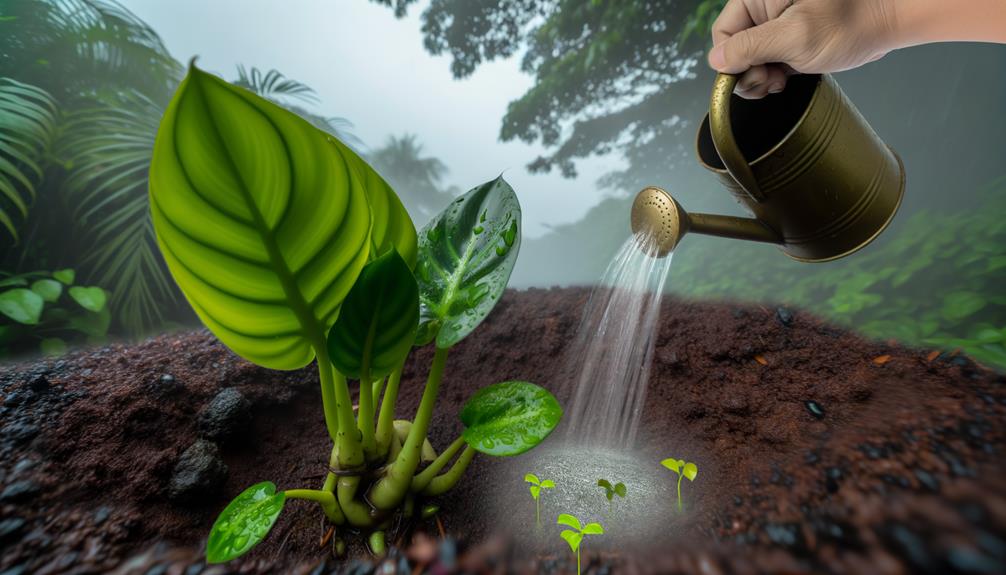
The best hydration of a Split Leaf Philodendron is essential for its overall health and vitality in an outdoor setting. Establishing an appropriate watering schedule is paramount, considering factors such as climate, season, and soil type.
Additionally, the implementation of effective strategies to prevent overwatering can greatly reduce the risk of root rot and other water-related diseases.
Determining Watering Frequency
Understanding the correct watering frequency for your Split Leaf Philodendron is essential, as overwatering or underwatering can lead to a variety of health problems for the plant.
In order to determine the suitable watering frequency, several factors should be taken into account:
- *Climate and seasonality*: These plants typically require more water during hot, dry seasons.
- *Growth phase*: More water is often needed during the growth phase.
- *Soil type*: Well-drained soil will need watering more frequently than heavy, wet soil.
- *Pot size*: Larger pots retain more moisture, reducing the need for frequent watering.
Overwatering Prevention Techniques
Having established the factors that influence watering frequency, it is equally important to outline techniques to prevent overwatering, a common pitfall that can severely impact the health of your Split Leaf Philodendron.
The first step is to make sure that your plant's pot has sufficient drainage to allow excess water to escape. Avoid letting the plant sit in a saucer of water, as it can cause root rot.
Additionally, using a moisture meter can help in determining when the soil is dry and needs watering. In general, it's better to underwater than overwater; it's easier to remedy dehydration than root rot.
Fertilizing for Vibrant Growth
Proper fertilization is essential for your Split Leaf Philodendron's vibrant growth, necessitating a well-balanced, slow-release formula applied during the active growing season. This guarantees that nutrients are gradually made available to the plant, promoting robust health and minimizing the risk of nutrient burn.
When fertilizing, keep in mind these key points:
- Utilize a complete, balanced fertilizer, typically with a ratio of 20-20-20 for Nitrogen, Phosphorus, and Potassium.
- Integrate organic matter, like compost or well-rotted manure, to enhance soil fertility.
- Fertilize every 4-6 weeks during the growing season, but decrease frequency during winter months.
- Always water before and after applying fertilizer to prevent root burn.
Implementing these strategies will enhance your plant care services, guaranteeing your Split Leaf Philodendron thrives outdoors with lush, vibrant foliage.
Pruning and Maintenance Tips
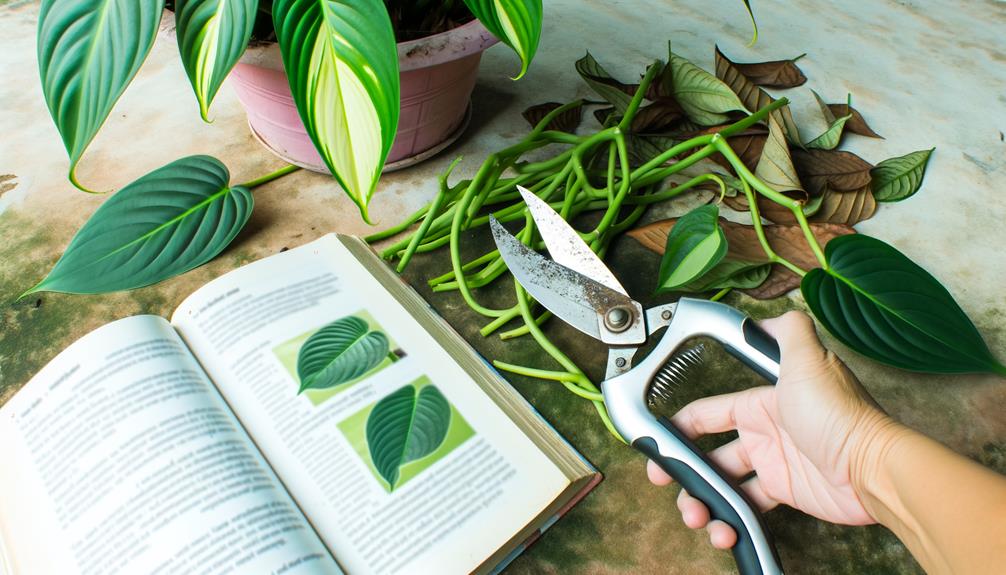
To maintain the health and aesthetics of your Split Leaf Philodendron, regular pruning and diligent maintenance are essential components of its care regimen.
Pruning should be conducted in early spring or late winter when the plant is dormant. Utilize sanitized shears to eliminate any yellow or brown leaves, as these signify aging or disease. Concurrently, remove any excess growth that may compromise the plant's structure or divert vital nutrients.
Alongside pruning, maintain a consistent watering schedule, ensuring the soil remains moist but not waterlogged. Additionally, monitor sunlight exposure; while Split Leaf Philodendrons appreciate bright, indirect light, excessive sunlight can lead to leaf scorch.
With conscientious pruning and maintenance, your plant will flourish, embodying the epitome of horticultural excellence.
Protecting From Pests and Diseases
The health and strength of your Split Leaf Philodendron can be greatly affected by various pests and diseases. Getting to know common plant pests, their signs and symptoms, is the first step in safeguarding your plant.
Moreover, strategic disease prevention measures and the integration of natural pest control methods are essential for a thorough approach to plant protection.
Identifying Common Plant Pests
Often, split leaf philodendrons can fall prey to several common pests such as aphids, mealybugs, and spider mites, necessitating vigilant monitoring and early intervention to maintain ideal plant health.
To identify these pests, consider the following:
- Aphids: These soft-bodied insects can be green, yellow, black, or brown. They suck plant sap causing curled, yellowed, and distorted leaves.
- Mealybugs: Characterized by their white, cottony appearance, they cause leaves to yellow and drop off.
- Spider Mites: These tiny, spider-like pests cause yellow or brown spots on leaves.
- Thrips: These minute, slender insects cause leaf distortion, silvering, or small white patches.
Understanding these pests and their effects are pivotal for the well-being of your philodendron. Early detection and treatment can prevent substantial damage to the plant.
Disease Prevention Strategies
Implementing robust disease prevention strategies is essential for protecting your split leaf philodendron from harmful pests and diseases. This begins with maintaining ideal plant health, as healthier plants are less prone to pest invasions and disease outbreaks.
Regular monitoring is also vital in early detection and intervention. Pay close attention to the plant's leaves, stems, and roots for any signs of pest activity or disease symptoms.
Proper sanitation practices, including disinfecting gardening tools and removing diseased plant parts, can help prevent the spread of pathogens. It's also important to apply appropriate watering and fertilizing techniques; overwatering or excessive fertilizing can lead to root rot and other diseases.
Lastly, consider using preventive treatments such as horticultural oils and systemic insecticides as part of an integrated pest management program.
Natural Pest Control Methods
Employing natural pest control methods not only preserves the health of your split leaf philodendron but also promotes a more sustainable approach to gardening. It's a practice that is safe, environmentally friendly, and effective when applied correctly.
Here are some strategies you can use:
- Companion Planting: Some plants naturally repel certain pests. Planting these alongside your philodendron can help protect it.
- Beneficial Insects: Introducing insects that prey on harmful pests, like ladybugs and lacewings, can maintain a balanced ecosystem in your garden.
- Homemade Sprays: Mixtures of water, mild soap, and certain spices can deter pests without harming your plant.
- Regular Monitoring: Regularly inspecting your plant for signs of pests allows early detection and intervention, preventing further damage.
Winterizing Your Philodendron
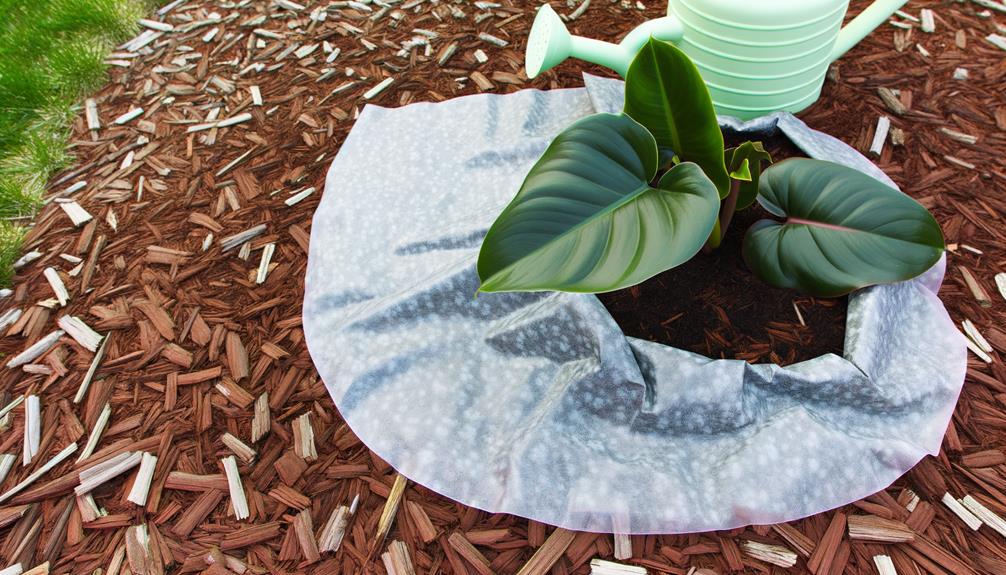
As winter approaches, proper preparation and care for your Split Leaf Philodendron become paramount in order to guarantee its survival during the colder months.
The first step is to reduce watering, as the plant's metabolic processes slow down in low temperatures, requiring less water.
It is recommended to apply a layer of mulch around the base of the plant to help insulate the roots from harsh winter cold.
If the plant is potted, consider moving it to a sheltered location to protect it from freezing temperatures.
Finally, cease all fertilization until spring to avoid encouraging new growth which can be damaged by frost.
With these measures, your Split Leaf Philodendron can successfully weather the winter months.
Recognizing Common Problems
Understanding the common issues that can plague your Split Leaf Philodendron is crucial for maintaining its health and longevity. These problems, if left unaddressed, can lead to irreversible damage, affecting the plant's overall well-being.
Here are some commonly encountered issues:
- Leaf Yellowing: Often due to overwatering, leading to waterlogged soil and root rot.
- Brown Leaf Tips: Typically an indication of low humidity or underwatering.
- Pests: Spider mites, mealybugs, and scale insects can infest your plant, causing stunted growth and leaf damage.
- Fungal Diseases: Manifest as black or brown spots on leaves, usually due to high humidity and poor air circulation.
Propagating Your Philodendron Outside

Having addressed common issues, let's now explore the process of propagating your Split Leaf Philodendron outside, a procedure that allows you to multiply your plant efficiently and effectively.
To propagate, select a healthy, mature leaf with an aerial root attached. Then, using a sterile cutter, create a cutting just below the node where the root is attached. Place this cutting into a pot with well-draining soil, ensuring the aerial root is covered.
Maintain a regular watering schedule, but avoid overwatering as it could cause root rot. The outdoor environment should be humid with indirect sunlight.
In about 4-6 weeks, new growth should appear, signifying successful propagation. This method is a sustainable, cost-effective way to augment your garden's fauna, benefiting the ecosystem immensely.
Conclusion
To sum up, the Split Leaf Philodendron's successful growth outdoors is a delicate balance of finding the right spot, watering adequately, and controlling pests, resulting in a vibrant, tropical look.
It's important to prioritize winter protection and promptly address any signs of distress.
Propagation, while challenging, offers the chance to increase the number of this alluring plant, transforming a garden into a lush paradise.
With careful attention, this tropical beauty can flourish and become a striking element of any outdoor area.

